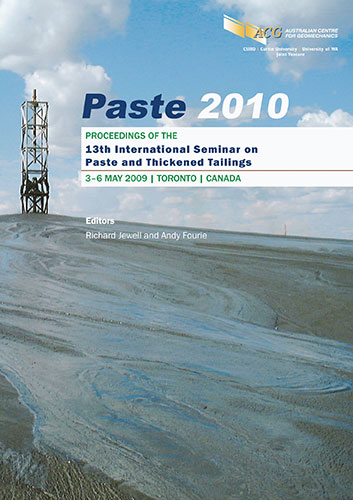‘Free’ water from thickened tailings

|
Authors: Solseng, PB; Wuolo,RW |
DOI https://doi.org/10.36487/ACG_rep/1063_45_Solseng
Cite As:
Solseng, PB & Wuolo,RW 2010, '‘Free’ water from thickened tailings', in R Jewell & AB Fourie (eds), Paste 2010: Proceedings of the Thirteenth International Seminar on Paste and Thickened Tailings, Australian Centre for Geomechanics, Perth, pp. 505-514, https://doi.org/10.36487/ACG_rep/1063_45_Solseng
Abstract:
Recent trends in tailings disposal are aimed at disposal without ‘dams’. Although tailings basins (and dams) can be designed, constructed, operated and closed safely and very economically, recent initiatives have focused on minimising the use of hydraulic structures for containing tailings. These initiatives have been (and should be) driven by decisions based on considerations for water supply and economic considerations associated with minimising risk from (1) the potential adverse environmental impacts with the ‘free’ water from thickened tailings, (2) having a dependable tailings management system for operating tailings dams, and (3) public perception with tailings dams. In most cases, water is the key factor in the evaluation of risk with tailings disposal. This paper will address some of the concepts used to estimate the quantity of ‘free’ water that is available from thickened tailings for recycling (if water shortage is a consideration) and to assess the potential risks for this ‘free’ water to cause adverse environmental impacts. Predictive flow modelling of thickened tailings, drainage, and the hydrologic settings in which thickened tailings are deposited is a key tool in quantifying ‘free’ water production. The movement of ‘free’ water from the thickened tailings will be discussed in the paper. Once the quantity of ‘free’ water is known, the associated risk may be evaluated more accurately. Two case histories will be presented that illustrate the concepts; one involving thickened tailings/paste from a soda ash facility in Wyoming, USA and one from flu gas desulpherisation (FGD) sludge from a coal-fired power plant in North Dakota, USA. General concepts for tailings disposal, with minimal use of ‘dams’ on projects that are currently under development, will also be discussed. The benefits, as well as the challenges of having ‘free’ water available within the thickened tailings during disposal will be addressed. Finally, ‘free’ water from thickened tailings and sludge must also be accounted for when evaluating the thixotropic characteristics of these materials. The role that salinity plays on thixotropy must be considered when designing containment structures for thickened tailings. This paper will discuss the thixotropy of thickened tailings and FGD sludge.
References:
Barr Engineering Co. (1978) Disposal of Residuals by Landfilling, prepared for Minnesota Pollution Control Agency.
McDonald, M.G. and Harbaugh, A.W. (1988) A Modular Three-Dimensional Finite-Difference Groundwater Flow
Model, U.S. Geological Survey Techniques of Water Resource Investigations, TWRI 6-A1, 575 p.
Mitchel, J.K. (1976) Fundamentals of Soil Behavior, University of California, Berkeley, John Wiley & Sons, Inc.
Sowers, G.B. and Sowers, G.F. (1970) Introductory Soil Mechanics and Foundations, Third Edition, The MacMillan
Company.
WASY Software (2004) FEFLOW® 5.1, Finite Element Subsurface Flow & Transport Simulation System. WASY
Institute for Water Resources Planning and Systems Research Ltd.
© Copyright 2025, Australian Centre for Geomechanics (ACG), The University of Western Australia. All rights reserved.
View copyright/legal information
Please direct any queries or error reports to repository-acg@uwa.edu.au
View copyright/legal information
Please direct any queries or error reports to repository-acg@uwa.edu.au